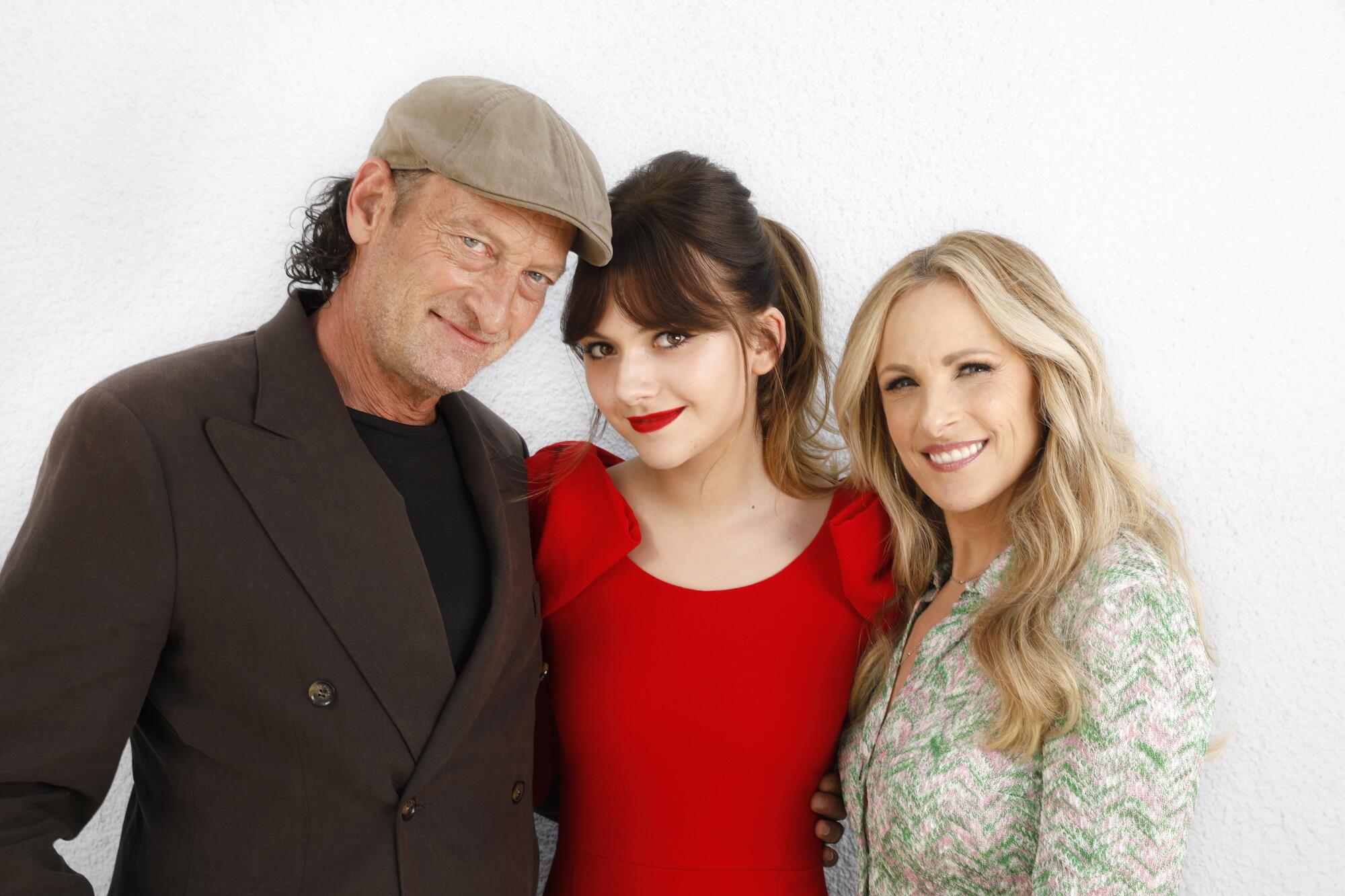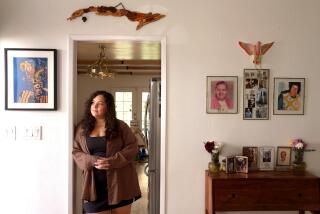
- Share via
Marlee Matlin had made only a minor suggestion. After being offered one of her “bucket list” roles — playing a judge on a television series — the actor was preparing for her four-episode arc when she realized there was something missing from the script. There was no role of courtroom interpreter, meaning Matlin’s character would not be able to understand all of the happenings in her workplace.
But when Matlin — who has been deaf since she was an infant — raised the issue with the showrunner, he balked.
“You can speak, Marlee. You can read lips. Why can’t you just play it the way it was written?” she recalled the TV producer asking.
Shortly after that conversation, Matlin said, she was dropped from the project.
“It’s outright discrimination,” said the 55-year-old, still incensed by the memory. “And I was devastated. But you know what? I wasn’t going to let it affect me. I wasn’t going to sit around and cry about it. I just moved on.”
This is the attitude she’s had to adopt in the 34 years since she won the Oscar for her leading role in “Children of a Lesser God.” She described it as a self-protective stance, cultivated to preserve her sanity in an industry that has so often dealt her rejection. On sets, she is almost always the only Deaf person. That never impacts her acting, she said, but it does influence how comfortable she feels socially. Because she is constantly accompanied by her interpreter — at lunch, say — she has been unable to have “a connection where [she] felt entirely relaxed communicating” at work.
And then “CODA” happened.
The coming-of-age movie ‘CODA’ is a beautiful story of a teen girl and her loving, Deaf family.
The film, which will be released in theaters and on Apple TV+ on Friday, is about a family whose two Deaf parents run a fishing business in Gloucester, Mass., with the aid of their kids — a son who also cannot hear and a daughter who can. Because the teenage girl is the only member of the household born hearing — hence the title, which stands for “child of Deaf adult” — she is regularly called upon to serve as a translator.
Matlin, who plays the matriarch, co-stars with two other Deaf actors: theater veteran Troy Kotsur, cast as her husband, and 31-year-old newcomer Daniel Durant as her on-screen son. Emilia Jones, a young Brit from the Netflix series “Locke & Key,” was hired only after she expressed a desire to learn American Sign Language in order to play the daughter caught between two worlds.
The movie, which swept the award ceremony at this year’s Sundance Film Festival, was purchased there by the streaming company for a record-breaking $25 million. But the film was unprecedented in other ways. Not only is it the first major Hollywood release to feature multiple Deaf leads, but its hearing director, Siân Heder, endeavored to make the set as accessible as possible. Shortly after Heder landed the gig to adapt “CODA,” based on a 2015 French César winner, “La Famille Bélier,” she began learning ASL. (Her instructor was Deaf actor Hillary Baack, whom the filmmaker was introduced to by Elliot Page; Heder and Page collaborated on 2016’s Netflix feature “Tallulah.”)
And after she’d finished a draft of the script, Heder connected with Alexandria Wailes, a Deaf actor who had served as an ASL consultant on productions including “A Quiet Place” and ABC’s “Quantico.” Over Thai food, the two women spent hours translating the script into ASL — a fluid process, since ASL is not a written language. For each line of dialogue, Wailes would offer her own signed interpretation and Heder would weigh in on the choice.
“Oftentimes, I would see the sign and realize I wanted to change the line,” said Heder. “There was one line that was like, ‘Do you want me to die here?’ But the sign for ‘die’ is not an active, angry sign; there’s something calm about it. So we chatted and I asked if there was something we could do that would be sharper and more dynamic. In that case, ‘You’re killing me’ was more like stabbing, so we went with that.”
Wailes, meanwhile, was jotting down ASL gloss — essentially “writing down in words what we’re going to sign,” she explained. Once they’d gone through the screenplay, Wailes recorded herself signing all of Jones’ lines and sent videos to the actor to study. Jones, who was in Toronto shooting “Locke & Key,” would then spend nine months working with Deaf Canadian actor Anselmo DeSousa to prepare for “CODA.”
“I was filming my show about 75 hours a week, but I was always fingerspelling between takes,” said Jones, 19, referring to the practice of using one’s fingers to form individual letters. “When I approach acting, I think I internalize my emotions because you can portray a lot through your eyes. But with sign language, you cannot; you have to inhabit what you’re saying because there are no words to hide behind. It made me a lot more vulnerable. I got out of my head.”

Heder, meanwhile, made a visit to the set of “This Close,” a Sundance Channel series co-created by Deaf actor Shoshannah Stern that features numerous Deaf performers. While observing, she picked up a few ideas to employ on “CODA,” like having an interpreter stationed at the monitor to speak the lines into a vocal track for a non-fluent ASL editor to refer to in post-production.
With “CODA” about to start shooting, Wailes and Anne Tomasetti — a Deaf actor who would serve as the ASL master on set — began familiarizing themselves with the Deaf culture in Massachusetts. There are more than 200 sign languages worldwide, and just like with English, there are various dialects.
“The Deaf community is small, and we have a circle of social networks all throughout the country, so we started reaching out on social media,” said Tomasetti. “We asked local Deaf people in Boston, ‘What sign do you use for crab or lobster?’ And they’d video themselves signing and send it to us.”
In rehearsals with the cast, the sign language evolved further. Though Wailes had offered foundational translations, seeing how the actors’ bodies moved often changed the interpretations.
“When we met and saw their signing style, we edited the signs so actors could wear them better,” said Tomasetti. “Maybe they would have to touch things to express the moment, instead of just signing. We never freeze the ASL translation, because there are so many ways to sign the same sentence.”

Kotsur, who developed his own sign-based vocabulary to play a Tusken Raider on the Disney+ series “The Mandalorian,” was particularly passionate about creating his own translations. In one scene where his character urges his daughter to wear a condom during sex, he pretended he was a soldier putting on a helmet and then used his arm to mimic a penis.
“A lot of the dirty language that was graphic, I wanted to bring it to another level and embellish it,” Kotsur said, laughing. “English can be limiting. It’s based on how things sound. A soldier with his helmet? I’m thinking, how can hearing people understand this? So I made it very picturesque and clear.”
(Heder said she later had a “whole conversation” with the MPA ratings board about the scene, explaining that what Kotsur had signed was literally the only way to say “ejaculate” in ASL.)
With rehearsals underway, the ASL consultants were busy vetting other elements of the production. They tried out various fishing gloves, making sure signs would still look clear enough when they were on the actors’ hands. They walked through the house where the family was supposed to live, making sure it realistically replicated a Deaf home — which it didn’t.
“It was all set up beautifully, and we came in and were like, ‘Uh, no,’” Wailes remembered.
“There wasn’t any way to sit and watch TV and have a conversation with each other; the sightlines were all messed up,” added Tomasetti.
Deaf people wouldn’t sit with their backs to the door because they wouldn’t be able to see someone coming in, Wailes and Tomasetti told the set designers. All of the seating should be in the round, allowing the characters to take in one another visually. And there needed to be fewer sharp corners, because if you’re walking and signing, you might accidentally jab yourself.
Even as production began, Heder wasn’t sure how many interpreters would be needed on set. At first, she used one to communicate with the actors, but after just four takes, scrapped the idea.
“It was really challenging for me to have someone else in the middle of that very intimate relationship,” said the director. “I didn’t realize, going in, how much the actor would be looking at the interpreter and not me. So I agreed with my actors that I would sign with them directly and we’d have the interpreter there to jump in. I was like, ‘You’re going to have to put up with a lot of ridiculous signing, and feel free to make fun of me when I get it wrong. We’ll always have someone there to clarify and make sure we’re all on the same page.’ But it was so great, because I think we did forge really strong relationships and developed such important communication about these characters that we wouldn’t have been able to find through the interpreters.”
But Tomasetti was still in constant communication with the actors. Before each take, she followed around the director of photography to see how the scene was being framed. She then took a photo of the monitor on her phone and brought it to the actors to show them whether they’d have to sign bigger or tighter in the space. When the cameras rolled, Tomasetti stood beside Heder at the monitor, making sure all of the ASL was accurate and that hands were clear in the shot. She would jot down which of the takes was the best from an ASL perspective and pass along her notes to the script supervisor to utilize during the editing process.
Tomasetti said the Deaf actors looked to her to confirm they were communicating clearly. “It was really important for them to focus and not be thinking, ‘These are all hearing people. Is anybody going to be able to understand me?’ I almost relieved them of that burden.”
That freedom allowed Matlin to focus more on her performance, which she felt had been overlooked by previous filmmakers she’d worked with.
“A lot of times directors, in my experience, tend to shoot me in two or three takes and say, ‘OK, fine, Marlee, let’s move on. That’s good enough,’” said Matlin. “They think by signing, I did my job — but they don’t actually pay attention to the performance that they might want to look for in actors who are hearing. At first, I thought, ‘OK, well, I must be doing something right for a director to just say, “Fine, let’s move on.”’ But the more it kept happening, I realized, they’re more concerned about time or lights or the next setup. Sian took me seriously as an actor.”
Jones, however, struggled with her new acting skill at times, and Tomasetti said the actor approached her “before and after every take to check that her signing performance was accurate.” During one challenging moment, the actor was filming on a small fishing boat while Tomasetti was observing from a video village on a nearby vessel.
“I could tell that she was stressed out and not feeling comfortable with her signs, because I was watching her through the monitors,” Tomasetti said. “She wasn’t able to see me, and we tried to communicate through FaceTime, but there was no service out at sea.”
The ASL master told the crew that she needed access to Jones, so a tiny transport boat pulled up to bring Tomasetti closer to the action. With the choppy waves rocking the transport craft three miles out at sea, Tomasetti stood up and signed Jones’ lines to her as the actor peered down from the picture boat.
Other important lessons were learned early on, including on the first night shoot, when Tomasetti noticed that the Deaf actors had no way of communicating with the crew because of how dark it was. After spending that night running around using her phone flashlight to help out, the crew adapted.
“They made a belt with a light at the end of it that would shine on the interpreters,” she said. “We were able to create a solution and never had any problems again.”
Creating an authentic collaboration between hearing and Deaf talent “was just unknown before,” said Heder. The director said she is eager to pass along everything she learned during “CODA” to other filmmakers and studios so they don’t feel “intimidated” by the process. In fact, she sees ASL as the ideal on-set language.
Jones said it taught her how much more fulfilling it is to “give people my full attention and eye contact.” And practically, Heder said, it served as a mode of communication that allows crew members to interact from far distances or make notes silently during takes.
“There are so many stories within these communities that need to be told. I feel frustrated about it. Disability representation on-screen has been abysmal,” said Heder. “But I feel hopeful about it too. Because I think the more people that respond to the movie and are inspired by these actors will encourage others to start creating roles. I hope these actors can become muses for other people the way that they are for me.”
More to Read
Only good movies
Get the Indie Focus newsletter, Mark Olsen's weekly guide to the world of cinema.
You may occasionally receive promotional content from the Los Angeles Times.











